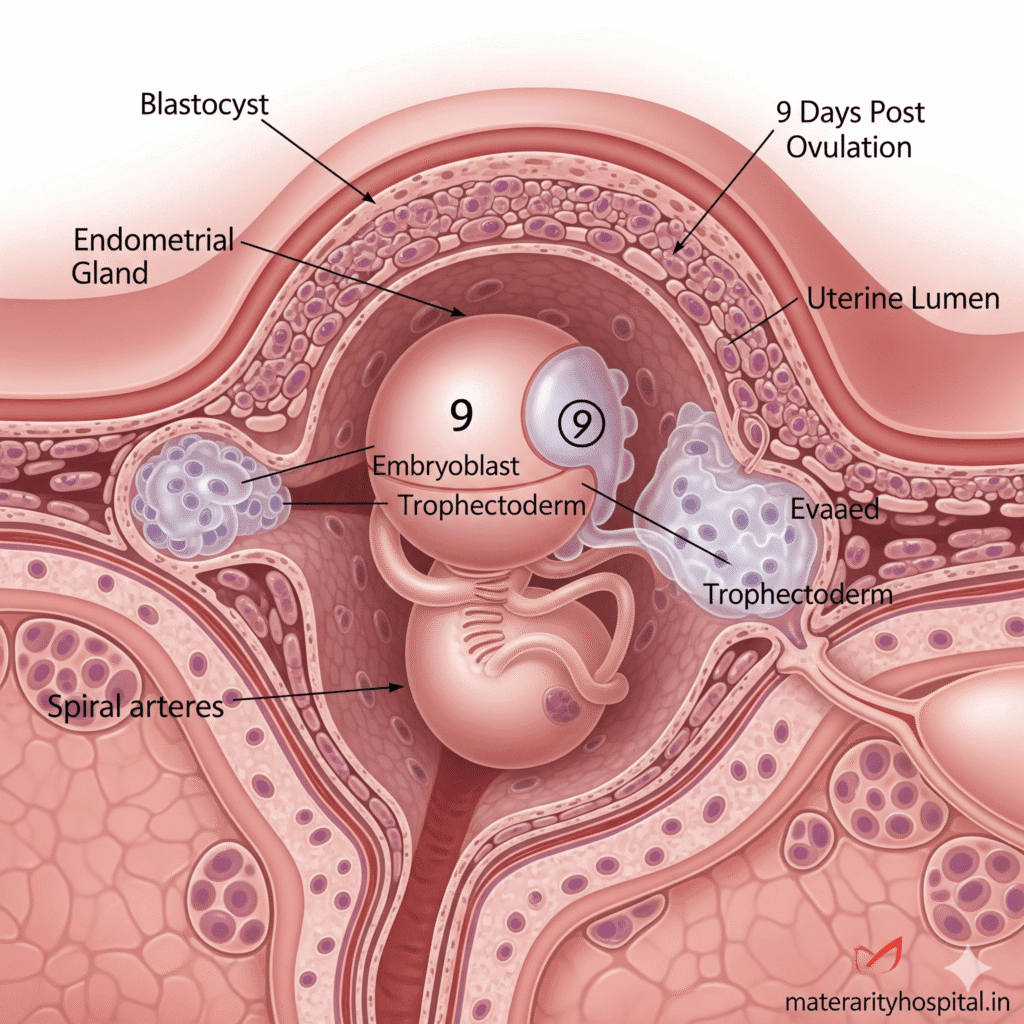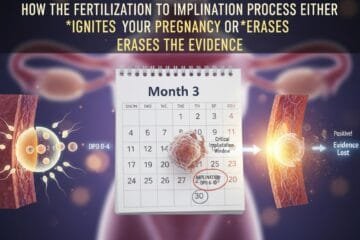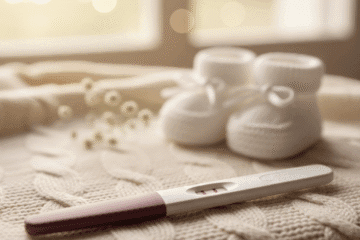
Your Ultimate Guide: What to Expect at 9 Days Past Ovulation
The Ultimate Hope: Why 9 Days Past Ovulation is So Significant
For anyone on the trying-to-conceive (TTC) journey, the period after ovulation—commonly known as the two-week wait—is a time filled with profound hope and meticulous self-observation. As you arrive at 9 days past ovulation, you have reached a truly critical moment. This is because 9 days past ovulation is considered the most common day for successful implantation to occur. While implantation can happen anywhere between 6 and 12 DPO, the statistical peak is right around this time. This makes the search for 9 DPO symptoms particularly intense, as many individuals are looking for the very first authentic sign that a fertilized egg has successfully nestled into its new home.
Understanding the science behind this day is crucial. By 9 days past ovulation, if conception occurred, the fertilized egg has transformed into a blastocyst and has likely completed its journey to the uterus. Implantation—the critical process of the blastocyst attaching to the uterine lining—is either happening now or has just completed. This means that any 9 dpo signs you experience now have a much higher probability of being directly linked to the onset of pregnancy itself, rather than solely to the general hormonal shifts of the luteal phase.
It’s important to remember that while the elevated levels of progesterone continue to dominate your body’s hormonal landscape, preparing the uterus for pregnancy and often mimicking premenstrual syndrome (PMS), the potential for early hCG production (the pregnancy hormone) is now more real. However, even with peak implantation, the amount of hCG is still very low, making it too early for most pregnancy tests. This article will provide an essential guide to the common 9 days past ovulation symptoms, helping you to interpret them with informed patience and manage the emotional rollercoaster of this crucial period.
What to Look For: Common 9 Days Past Ovulation Symptoms
At 9 days past ovulation, your body is in a state of heightened hormonal activity. Progesterone levels are high, and crucially, if implantation has occurred, your body has just started, or is about to start, producing trace amounts of hCG. This makes the 9 dpo signs particularly interesting, as some may begin to hint at actual pregnancy rather than just the luteal phase.
Here’s a detailed look at the most commonly reported physical and emotional sensations at 9 DPO, often considered potential early pregnancy signs:
1. Implantation Cramping and Spotting:
- What it feels like: This is a key focus for those seeking 9 days past ovulation symptoms. You might experience very mild, light cramping, often described as a subtle pulling, fluttering, or dull ache in your lower abdomen. It’s typically much less intense and shorter-lived than menstrual cramps.
- Why it happens: This sensation is believed to be a direct result of the blastocyst implanting into the uterine wall. The burrowing process can cause minor irritation. This is a classic implantation symptom.
- Implantation Spotting: Light pink or brown spotting (not a heavy flow) may occur. This is often very minimal and lasts only a day or two. While often associated with early pregnancy, it’s experienced by only a minority of pregnant women, so its absence is not a cause for concern.
2. Breast Tenderness, Soreness, or Heaviness:
- What it feels like: Your breasts may feel fuller, heavier, or more sensitive to touch than usual. The nipples might also become more pronounced or sensitive. These 9 dpo signs are often quite noticeable.
- Why it happens: Elevated progesterone levels are primarily responsible. This hormone increases blood flow and fluid retention in the mammary glands, causing swelling and tenderness. While a strong 9 days past ovulation symptom, it’s also common before a period.
3. Fatigue or Unusual Tiredness:
- What it feels like: A profound sense of exhaustion or extreme tiredness, even after adequate sleep. You might feel unusually sluggish or find yourself needing naps throughout the day.
- Why it happens: Progesterone is a powerful sedative. The high and sustained levels of this hormone during the luteal phase, especially around 9 dpo, can induce significant drowsiness and fatigue, making it a very common symptom regardless of conception.
4. Heightened Sense of Smell or Taste Changes:
- What it feels like: Ordinary smells might suddenly seem overwhelming, unpleasant, or even nauseating. Some individuals report a metallic taste in their mouth or a distinct change in how familiar foods taste.
- Why it happens: While primarily linked to rising hCG, subtle changes can occur as early as 9 days past ovulation if implantation has begun. Hormonal shifts can affect your olfactory and gustatory senses. These can be strong early pregnancy signs.
5. Changes in Vaginal Discharge:
- What it feels like: You might notice an increase in white, creamy, or lotion-like discharge. It may feel thicker or more “wet” than usual.
- Why it happens: Progesterone causes cervical mucus to thicken and increase in quantity after ovulation, creating a protective plug for the uterus. This is a normal part of the luteal phase cycle, but it’s often closely observed for 9 dpo signs.
6. Mild Headaches:
- What it feels like: Some women report experiencing mild, occasional headaches, which could be dull or throbbing.
- Why it happens: Hormonal fluctuations are a common trigger for headaches. The changing levels of estrogen and progesterone during the luteal phase can affect blood vessels and neurotransmitters, contributing to head pain at 9 days past ovulation.
7. Mood Swings or Heightened Emotional Sensitivity:
- What it feels like: You might feel more irritable, emotional, anxious, or prone to sudden shifts in mood—from elated to tearful in moments.
- Why it happens: The significant hormonal fluctuations, particularly the sustained rise in progesterone, can impact brain chemistry, leading to these emotional changes. This is very similar to premenstrual syndrome (PMS) symptoms during the two-week wait.
It is crucial to remember that while these are common 9 days past ovulation symptoms, they are not definitive proof of pregnancy. Many of these signs can be experienced during a regular menstrual cycle. The most accurate confirmation will come from a positive pregnancy test, taken after enough hCG has built up in your system.
The Science of Implantation at 9 DPO

Understanding the intricate scientific processes at 9 dpo is key to interpreting any perceived 9 days past ovulation symptoms. This day is particularly significant because it falls squarely within the peak window for implantation.
The Blastocyst’s Crucial Step:
By 9 days past ovulation, if fertilization was successful, the developing embryo is a blastocyst. It has successfully traversed the fallopian tube and reached the uterine cavity. At this stage, the blastocyst actively “hatches” from its protective outer layer and then firmly attaches to the specially prepared uterine lining. This attachment marks the critical beginning of implantation. The uterine lining, richly prepared and thickened by progesterone, is highly receptive to the blastocyst.
Implantation Triggers hCG Production:
Once the blastocyst successfully implants, your body immediately begins to produce Human Chorionic Gonadotropin (hCG). This is the groundbreaking hormone that all home pregnancy tests (HPTs) are designed to detect. hCG plays an absolutely crucial role: it signals the corpus luteum (the temporary gland formed after ovulation) to continue producing progesterone. Without this vital hCG signal, the corpus luteum would naturally degenerate, progesterone levels would plummet, and menstruation would commence.
Why 9 DPO Symptoms are Still a Mix of Hormones:
Even though 9 days past ovulation is a peak day for implantation, the initial amount of hCG produced is still extremely small. It takes a few more days for hCG levels to rise enough to cause widespread symptoms or to be reliably detected by even the most sensitive HPTs. Therefore, while some 9 dpo signs like light cramping or spotting could be directly related to implantation, the majority of the sensations you might feel—such as breast tenderness, fatigue, and mood changes—are still predominantly driven by the high and persistent levels of progesterone. This explains why distinguishing early pregnancy signs from typical PMS can be so challenging during the two-week wait.
Navigating the Emotional Landscape of 9 DPO
The two-week wait, especially at the 9 dpo mark, can be an emotionally charged period. The intensified search for 9 days past ovulation symptoms can lead to significant stress and anxiety, which is not conducive to overall well-being. Managing your emotions and nurturing your physical health is incredibly important during this sensitive time.
Strategies for Emotional Well-being at 9 DPO:
- Practice Mindfulness and Relaxation: Engage in activities that help keep you calm and present. Meditation, deep breathing exercises, or restorative yoga can significantly reduce anxiety levels.
- Distraction is Your Ally: Actively seek out enjoyable distractions. Immerse yourself in hobbies, watch engaging movies, read captivating books, or spend quality time with loved ones. Diverting your focus from constant symptom-spotting is key to managing stress during the two-week wait at 9 dpo.
- Lean on Your Support System: Share your feelings and experiences with your partner, a trusted friend, or a family member who understands your journey. Connecting with others can provide immense comfort. Consider joining an online TTC community for shared experiences and support regarding 9 days past ovulation signs.
- Limit Excessive Online Searching: While it’s natural to seek information on 9 dpo symptoms, constant “Dr. Google” searches can lead to misinformation and heightened anxiety. Stick to reputable sources and limit your screen time.
Supporting Your Physical Health at 9 DPO:
- Continue Prenatal Vitamins: Ensure consistent intake of your prenatal vitamin, especially one with folic acid, which is vital for early fetal development.
- Maintain a Nutrient-Rich Diet: Focus on a balanced diet rich in whole foods, lean proteins, healthy fats, and an abundance of fruits and vegetables. Avoid processed foods, excessive sugar, and artificial ingredients.
- Stay Well-Hydrated: Drink plenty of water throughout the day. Proper hydration supports all bodily functions and can help alleviate any progesterone-induced constipation, a common 9 dpo symptom.
- Engage in Gentle Exercise: Continue with light to moderate physical activity that you are already accustomed to, such as walking, swimming, or prenatal-friendly exercises. Avoid introducing intense new routines.
- Prioritize Rest: Aim for at least 7-9 hours of quality sleep. The naturally high progesterone levels at 9 days past ovulation can often make you feel more tired, so listen to your body’s need for rest.
By actively focusing on these strategies, you empower yourself to navigate the uncertainty of 9 dpo with greater calm and patience. Remember, you are doing everything you can to create a healthy environment, and now it’s a matter of waiting for your body to provide a clearer answer.
When to Test for Accuracy & Important Resources
The question, “When should I take a pregnancy test?” is often the most pressing during the two-week wait. When you’re keenly observing 9 days past ovulation symptoms, the temptation to test is incredibly strong. However, for the most accurate results and to avoid unnecessary disappointment, timing is paramount.
The Timing of Pregnancy Testing for 9 DPO:
- At 9 DPO: It is still too early for a reliable pregnancy test for most people. Even though 9 days past ovulation is a peak day for implantation, the hCG levels in your system will just be starting to rise and are likely too low for even the most sensitive home pregnancy tests (HPTs) to detect. A negative result at 9 DPO is much more common and should be considered a false negative rather than a definitive answer. Wait a few more days for accuracy.
- Earliest Recommended Testing: Most “early detection” HPTs suggest testing no earlier than 10 DPO. By this point, sufficient time has passed for implantation to occur, and for hCG levels to accumulate to a detectable level.
- Most Accurate Results: For the highest accuracy, it is strongly recommended to wait until the day of your missed period. By this time, hCG levels are typically high enough for nearly all HPTs to provide a clear and reliable result.
Resist the urge to test too early during this two-week wait at 9 dpo. Frequent early testing can be costly, emotionally draining, and ultimately uninformative.
When to Contact Your Healthcare Provider:
While most 9 dpo symptoms are normal physiological responses during the luteal phase, it’s always wise to be aware of any concerning signs. You should contact your doctor if you experience:
- Heavy, bright red vaginal bleeding that is more like a period than light spotting.
- Severe, sharp, or persistent abdominal pain that feels unusual or intense.
- Signs of infection, such as fever, chills, or unusual discharge with an unpleasant odor.
- Any symptom that causes you significant distress or worry, or feels genuinely abnormal for your body.
Official and Reliable Resources:
For further trustworthy information on pregnancy, conception, and women’s health, consult these authoritative organizations. These are DoFollow links that provide evidence-based guidance:
- American College of Obstetricians and Gynecologists (ACOG): https://www.acog.org/ – Comprehensive information on women’s health and pregnancy care.
- Centers for Disease Control and Prevention (CDC) – Pregnancy: https://www.cdc.gov/pregnancy/ – Government health guidelines and facts about pregnancy.
- National Institutes of Health (NIH) – Pregnancy: https://www.nichd.nih.gov/health/topics/pregnancy – Research and health information from the NIH on pregnancy and child development.
- Planned Parenthood – Pregnancy Tests: https://www.plannedparenthood.org/learn/pregnancy/pregnancy-tests – Clear information on how pregnancy tests work and when to use them.
- Mayo Clinic – Early Pregnancy Symptoms: https://www.mayoclinic.org/healthy-lifestyle/getting-pregnant/in-depth/symptoms-of-pregnancy/art-20046194 – Expert-reviewed information on the earliest signs of pregnancy.
These resources can empower you with accurate information, helping you to make informed decisions and manage your journey with confidence.
Add Your Heading Text Here
Lorem ipsum dolor sit amet, consectetur adipiscing elit. Ut elit tellus, luctus nec ullamcorper mattis, pulvinar dapibus leo.










